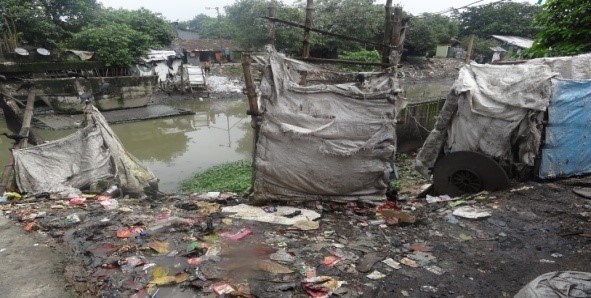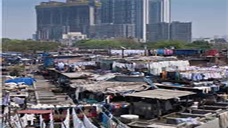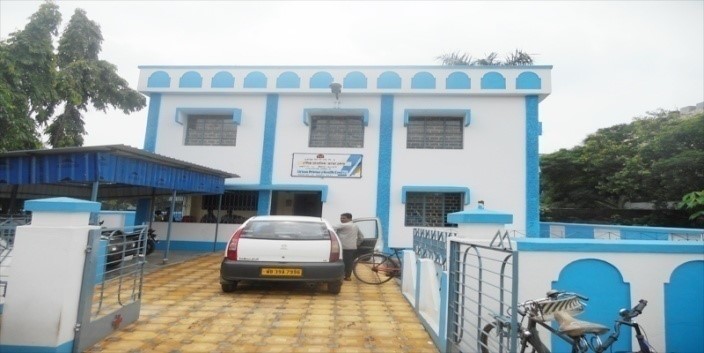The last century saw a qualitative change in the nature of cities. While, in the previous centuries, cities were compact; rapid industrialization, invention of automobiles, cheap land and inexpensive fossil fuels led to the emergence of dispersed cities. As automobiles became popular, more and more infrastructure such as roads began to be built. This led to the deterioration of environmental parameters of cities, increased footprints and impermeable surfaces, reducing water availability and quality, reducing greenery and increasing air and noise pollution. The adverse effects of this automobile-led growth of cities led planners and urban managers to look for innovative ways to promote economic and urban growth with minimum environmental impact.
Several theories and concepts addressing the problem continue to be developed. The idea of sustainable economic growth was introduced in the 1980s. That economic growth, environmental preservation and social development could be reconciled was subsequently demonstrated. Concepts of walkable neighbourhoods and mixed land use were advocated to limit dispersed urban expansion of cities. Concepts such as sustainable city, green urbanism, livable city, compact city are at the centre of the discussions surrounding city designs, urban form, use of natural resources, energy use, all linked to urban sustainability.
With climate change occupying centerstage in the public debate in the current century, energy and resource efficiency came to the centre of the discussion on development of sustainable cities. These developments culminated in the development of the term “green” with relation to cities, signifying sustainability and eco-friendliness.
Concomitant with climate change issues, air and water pollution became a matter of increasing concern. While climate change is an important issue, yet its causes and effects are felt at a scale much larger than a city; pollution impacts began to be observed and measured at the sub-city level. The immediate health effects of air and water pollution brought an urgency to planning for addressing pollution. Greening cities thus became a matter of immediate necessity.
Scenario in West Bengal
Along with the rest of India, West Bengal too is facing rapid urbanization. The state’s urban population rose from 27.8% in 2001 to 31.0% in 2011. It is estimated that the majority of its population would reside in the cities in a few decades, within 2039 by certain estimates. The State Government has published its township policy. It lays emphasis on providing affordable housing for the poor and creating jobs through giving an economic focus in planning, that is, by earmarking non-residential areas that would form clusters of investments and growth. This alone was not enough. To make development, sustainable, it was necessary to plan for cities that would be sustainable, resilient, environment-friendly, livable, energy positive, IT-friendly and safe. This led to the launch of the Green City Mission in all municipalities, municipal corporations and in the jurisdiction of Development Authorities.
Delhi had always been on the radar of the environmentalists due to the rapidly deteriorating air quality. While pollution in Delhi hit the national headlines in the latter part of last year, Kolkata followed quickly and registered an air quality even worse than Delhi for a period! New Delhi based research and advocacy agency, Centre for Science and Environment (CSE) analyzing the data from the official ambient monitoring reported by the Central Pollution Control Board and West Bengal State Pollution Control Board reported that particulate levels (PM10) in 78 per cent of cities in West Bengal exceed the standards. All cities exceed the NO2 standard. This is a warning bell. Acting rapidly on such findings, the state government decided to initiate a programme to improve the physical environment in the cities in Bengal.
The Green City Mission
The Standing Committee of the Cabinet on Industry, Infrastructure & Employment, in their meeting held on 4th July 2016, approved the concept of Green City Mission proposed by the Urban Development and Municipal Affairs Department in principle. The same committee also approved the formation of a High Powered Committee headed by the Chief Secretary of the state. The Implementation Mechanism of the Green City Mission was also approved. The High Powered Committee was constituted with the Departmental Heads of various Departments under the chairmanship of the Chief Secretary.
At inception, the Green City Mission encouraged city governments to come up with schemes to increase green areas, conserve water bodies, beautify public spaces. The Mission consists of the following components:
- Greening plan – (i) Urban afforestation, (ii) Parks (both creation and revival), (iii) Nurseries, Floriculture, (iv) Pocket Forests, (v) Plantation along the median of the roads.
- Blueing plan – (i) Conservation of water bodies, (ii) Water based recreation, (iii) Canal/water front development, (iv) Hedges along water front.
- Cleaning and Beautification programme – (i) Landscaping of important locations and buildings of the city, (ii) Placement of adequate dust bins at important locations, (iii) Construction of Pay & Use toilets, (iv) Specific measures for reduction of air, sound and visual pollution, (v) Emphasis on Mission Nirmal Bangla, (vi) Programme for landscaping of important city landmarks, (vii) Use of dumpers and compactor machines, (viii) Improvement of Solid Waste Management, (ix) Development of roadside architecture.
- Building Energy Positive City – (i) Installation of solar panel at important buildings (ii) Use of LED lights at roads and public spaces (iii) Introducing incentives for Green Building.
- Sustainable Public Transport – (i) Use of battery operated vehicles, (ii) Building cycle tracks, (iii) Construction of modern bus stands, (iv) Building of eco friendly parking space, (v) Building of adequate sub ways.
- Making city technology efficient – (i) Creating wi-fi hotspots as much as possible and coverage of important office and other public spaces with strong wi-fi network, (ii) Setting up of e-Sewa Kendras, (iii) Skill upgradation plan of technical wing of city administration, (iv) Provision for underground utility tunnel (both for wet and dry purpose), (v) Using GPS based compactors and monitoring.
- Making City safe and secure – (i) Installation of CCTV at important locations, (ii) Setting up of Web based system for centrally monitoring security aspect of the City.
- Livelihood Generation Plan – (i) Formation and running of City Livelihood centres, (ii) Provision of sales counter/outlets for keeping non PDS product.
- Ensuring better quality of city life and grievance management – (i) Installation of water ATMs at important public spaces, (ii) Setting benches for citizens at Parks and Hospitals, (iii) Creation of hawker free zones.
The list is not exhaustive. It was decided that any other initiatives could be taken up for execution which will be considered admissible by High Powered Steering Committee, headed by the Chief Secretary from time to time. Two meetings were held by this committee for approval of the schemes submitted by the ULBs/Development Authorities and some other decisions relating to the Green City Mission were also taken by the said committee. It was felt that the resources under the mission should be directed specifically to improve the environment in the cities and should not be utilized to create other infrastructure, which though necessary have less of an impact on the greening of the city. The following types of works are strictly not permissible under Green City Mission:
(a) Construction of roads, (b) Water supply scheme, (c) Drainage related scheme, (d) Construction of office building, (e) Procurement of office materials.
The government realized that given the level of technical resources available with most of the urban local bodies in the state, they would need technical support to prepare good projects with maximum impact. A number of teams were forms to assist the urban bodies in preparation and execution of the projects.
Project Monitoring and Evaluation
- Technical Committee: The Technical Committee comprising of various technical persons examines the technical, financial and legal aspects relating to the projects under Green City Mission.
- Technical Vetting Cell: The DPRs/Estimates relating to the Green City Mission schemes are vetted by the Technical Vetting Cell of Municipal Engineering Directorate (MED) or the Kolkata Metropolitan Development Authority (KMDA) or the Public Works Department (PWD) or the Public Health Engineering Department (PHED) or the Salt Lake Reclamation and Development (SLRDC).
- Engineering Cell in UD & MA Department: There is an Engineering Cell comprising of Executive Engineer and Assistant Engineers under this Department which scrutinizes and verifies the technical feasibility of the schemes in the light of the operational guideline of Green City Mission.
- Quality Monitoring of schemes: A Quality Monitoring Team, consisting of technical persons, was formed to visit the Municipalities/ Development Authorities to monitor the works as well as to assess the status of the schemes being executed under the Green City Mission.
Approval of Projects under the Green City Mission
The urban local bodies and Development Authorities prepare the DPRs/Estimates as per the Guideline of the Green City Mission and get the DPRs/Estimates vetted by the competent authority of Municipal Engineering Directorate or KMDA (for KMA area only), PWD, PHED or by the office of the Special Engineer, SLRDC and submits the same to the UD and MA Department for approval.
The improvement of public spaces such as development of parks, green strips, footpaths, afforestation and landscaping around heritage buildings, district and sub-divisional hospitals have received priority. Conservation of Water Bodies has also been taken up by many municipal bodies.
To give increased priority to some components of the Green City Mission, some schemes have subsequently been announced within the mission.
a) Aloshree: This scheme was launched with the objective of installing Grid Connected Solar Photovoltaic (GRTSPV) System in all Government Buildings and Buildings of Local Bodies (technically fit for such installation). These projects are being implemented through WBREDA.
b) Heritage Towns: The towns of Coochbihar and Nabadwip are steeped in history and still retains significant heritage sites. These two towns were declared Heritage Towns in a meeting held on 7th August 2017 under the chairmanship of Chief Secretary. It was decided to rejuvenate and beautify the towns of Coochbehar Town through the following interventions:
- Renovation and rejuvenation of identified tanks/water bodies.
- Laying of underground power cables for the Core Zone.
- Drainage/sewerage and solid waste management.
- Improvement of Street Lighting with LED lights.
- Traffic Management.
In the case of Nabadwip the following interventions were identified:
- Drainage/sewerage and solid waste management.
- Renovation of Ghats.
- Improvement of Street Lighting with LED lighting.
- Completion of laying of underground power cables for the Core Zone.
- Traffic Management.
The West Bengal State Electricity Distribution Company Ltd. prepared estimates for converting the overhead lines to underground cables in the core zone of the towns. Rs. 73.68 crore has been earmarked for this project. Consultancy contracts were signed with IIEST, Shibpur and IIT, Kharagpur to study Nabadwip and Coochbihar respectively and come up with recommendations for the preservation of heritage in these two towns.
c) Beautification during FIFA: The FIFA U-17 World Cup, 2017 was held in West Bengal during October, 2017. During this period a good number of international visitors, players and delegates visited Kolkata. The traffic system was improved, LED luminaires were installed in major roads and road-side beautification were carried out from the Yuva Bharati Krirangan to the Netaji Subhas Chandra Bose International Airport. The initiatives taken to beautify the city has left a permanent impact.
The Green City Mission has found wide acceptance among the urban local bodies who have accessed the funds for improving the cityscape. Since inception of Green City Mission sanction for as many as 3109 projects with an estimated cost of Rs.1605.89 crore has been given. Of these, Rs. 806.45 crore has been released to the implementing agencies, primarily in the sectors of LED street lighting, High Mast lights, water body renovation, green space development and miscellaneous projects such as seating arrangements, bus stand sheds, community toilets, water ATMs etc. While many of these are directed towards infrastructure development in the cities, the close nexus between the investments made under Green City and the long term health of the citizens is in many cases, obvious.
Roadmap for the Future
The Green City Mission has achieved a degree of maturity over the last three years. There is significant convergence between government departments and parastatals during planning and implementation of the projects. A large number of assets have been created, the maintenance of which would be a challenge in the years to come. Also most of the assets created are not revenue generating. The city governments will therefore have to work out a model to earn additional revenue to maintain these assets.
The government is exploring a few alternative means of financing Green City projects. One is an annuity model for installation of street lights which ensures Operation and Maintenance for seven years against annual payments.
There is enormous scope for the participation of the private sector in several areas, such as development of theme parks, ropeways and other facilities of tourist interest.
Management of solid waste in a scientific manner is an essential feature of any modern city. Efforts are on to implement scientific solid waste management in all towns and cities in West Bengal. The high density of population, unplanned growth over many decades, low level of public awareness, lack of technical capacity of the city governments, scarcity of land for waste disposal are some of the impediments which have to be considered while designing viable systems for solid waste management.
 Accessibility Tools
Accessibility Tools






